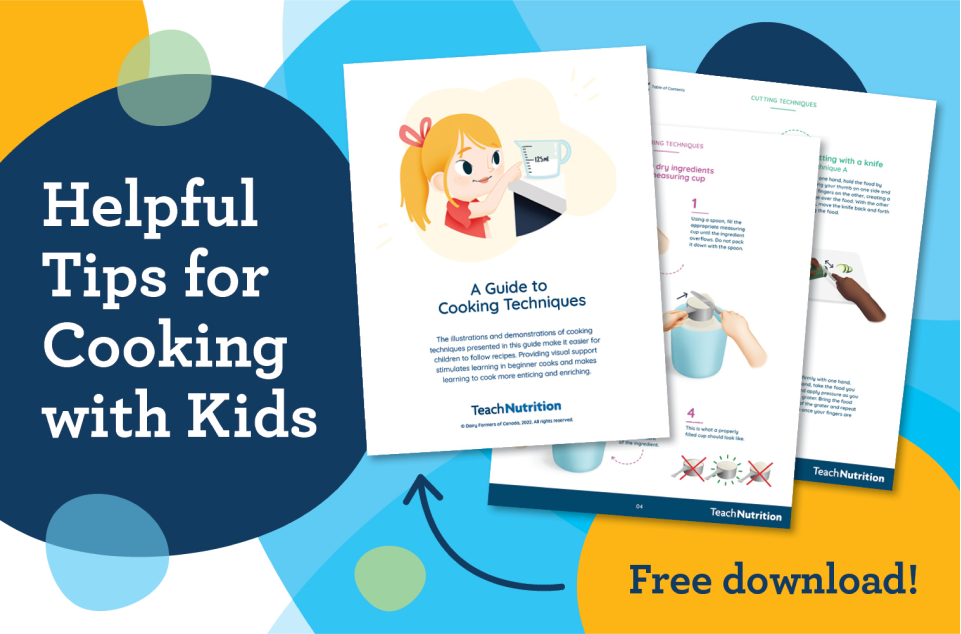Cooking with kids can be fun, messy, and full of learning. Explore simple tips to help you get started, along with a free downloadable resource that shows key food skills in action.
Cooking with children opens the door to hands-on learning, skill-building, and fun. Whether at home, in a classroom, or in a child care setting, food-based activities can spark curiosity and connection in powerful ways.
This article explores the many benefits of cooking with kids, offers tips to help you get started, and includes a free downloadable guide with images of key food skills.
Benefits of Cooking with Kids
Food skills
Involving children in hands-on food preparation activities develops fine motor skills and builds practical food skills, such as learning to plan, prepare, store, and eat food. Practising these skills connects children with the many roles of food in their lives and supports food literacy from an early age.
Exposure
Children may be cautious when introduced to a new food. Before tasting a food, children may wish to see it, touch it, smell it, or observe others eating it. When children contribute to food preparation, they gain exposure to the food they are making and often get excited about it. This exposure and excitement may encourage them to try it, but if not, that’s okay! Each child is on their own food journey.
Learning opportunities
When children cook, they learn about more than just food. Science, math, reading, communication, history, food systems, and more can be easily woven into a cooking activity.
How to Start Cooking with Kids
Whether you are planning a cooking lesson for your classroom or for a group of early learners (or even cooking with kids at home), the tips we’ve compiled will make your cooking activity a success.
- Choose a recipe that everyone can enjoy: Find out what foods the children are interested in and consider any food allergies, intolerances, and restrictions when choosing a recipe. Determine how many portions you will need. You can browse our Classroom Kitchen recipe library for kid-approved recipes designed with group settings in mind!
- Gather the materials: Collect the ingredients and equipment you will need for your recipe. It’s okay if you don’t have access to a full kitchen. No-cook or assembly-only recipes still count. Equipment such as mixing bowls, cutting boards, knives, blenders, electric grills, microwaves, and griddles offer a lot of flexibility for bringing the kitchen to the classroom.
- Organize your space: Decide if and how you will divide children into groups and rearrange your space as needed. You may decide to have groups take turns making the recipe or assign different roles to each group. Do whatever works best for your group, space, and chosen recipe.
- Recruit support: It may be useful to have extra hands and eyes to supervise and assist with your cooking activity, especially with large groups or when working with younger children. Gracious teaching or education assistants, parents, grandparents, and older children are great allies.
- Trust that kids are capable: It may be nerve-wracking to involve children in the kitchen, but don’t worry – there are many tasks they can do with supervision. Even in preschool, children can help with tasks such as mixing, whisking, measuring, slicing ingredients with a butter knife, and assembling ingredients. Trust that they are capable and allow them to decide whether and how much they would like to be involved.
- Enjoy food together: Sharing food forms connections. Take time to come together, eat, and share thoughts about your cooking experience as a group. This is a great opportunity to explore food, ask for feedback, and reflect on the experience. Ask children what they liked, what they found difficult, and if there was anything they would change. Remember, every child is on their own food journey, and it’s okay if they are not ready to try the recipe that day.
A Guide to Cooking Techniques
If you are looking for a way to demonstrate cooking techniques to children, check out our free resource, A Guide to Cooking Techniques, below. And if you’re in need of recipe ideas, our Classroom Kitchen recipe library is the perfect place to start. Each recipe comes with a step-by-step video and downloadable recipe card.


